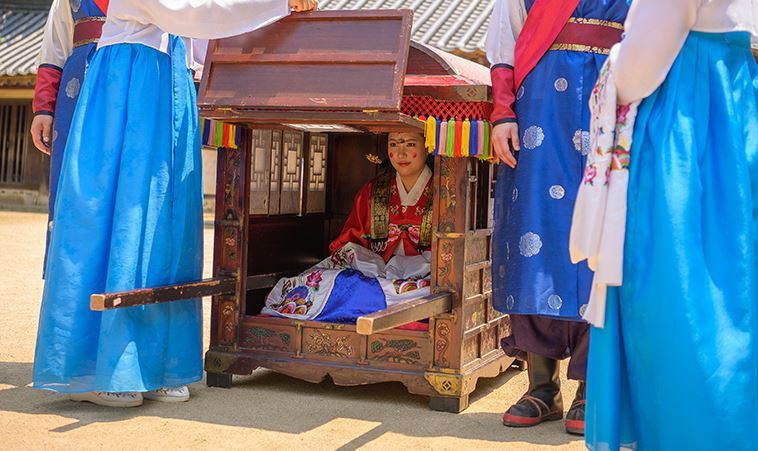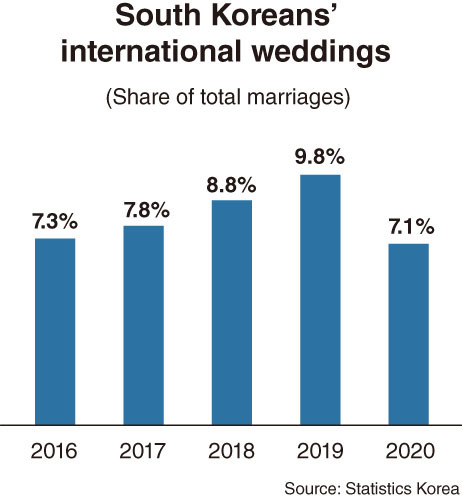 |
A Korean traditional wedding is reenacted at the Korean Folk Village in Yongin, Gyeonggi Province, in this promotional image from its homepage. (Korean Folk Village) |
SEJONG -- Of all marriages in South Korea, the percentage of international marriages -- marriages between Koreans and foreign nationals -- plummeted again last year, possibly because of the COVID-19 pandemic, government data showed.
The percentage of international marriages had bounced back in the years 2016 through 2019 after a decadelong decline.
In 2000, when the nation started compiling data on marriages between Koreans and foreigners, international marriages made up only 3.4 percent of all marriages in Korea, Statistics Korea data showed.
That figure climbed sharply to 4.5 percent in 2001, 4.9 percent in 2002, 8.1 percent in 2003 and 11.2 percent in 2004.
In 2005 it peaked at 13.4 percent, or 42,356 marriages out of 314,304. Of those international marriages 30,719 were between Korean men and foreign women, and 11,637 were between Korean women and foreign men.
 |
(Graphic by Kim Sun-young/The Korea Herald) |
But the figures began a downhill trajectory, with international marriages falling to 10.7 percent of the total in 2009 and continuing to drop. They comprised 10.4 percent of all marriages in 2010, 9 percent in 2011, 8.6 percent in 2012, 8 percent in 2013 and 7.6 percent in 2014.
After bottoming out at 7 percent in 2015, the figures bounced back to 7.3 percent in 2016, 7.8 percent in 2017, 8.8 percent in 2018 and 9.8 percent in 2019.
In 2020 the percentage of international marriages again plunged, posting 7.1 percent, or 15,341, of the nation’s 213,502 marriages. Of those couples 11,100 consisted of Korean husbands and foreign wives, and 4,241 were Korean wives and foreign husbands.
The 2020 figure marked the lowest for the five years from 2016-2020, and the second-lowest for the 18 years from 2003-2020.
A demographic researcher said the sharp decrease could be attributable to the severe restrictions on overseas movement in the wake of the novel coronavirus.
“The downsized portion in international marriages is projected to continue this year,” he said. “Of interest is whether the portion will gradually rebound, as it did in the late 2010s, after the situation is normalized from the pandemic.”
In the 2000s a growing number of Korean men, particularly those engaged in farming or fishing, wedded women from Southeast or Central Asia. The trend has diminished somewhat amid a sharply declining number of young male workers in rural regions across the nation.
Some analysts predict that the percentage of international marriages will increase in the coming years, pointing out the continual rise in Korea’s foreign population and the steady fall in its overall population since late 2019.
Though the number of foreigners staying in Korea had fallen to its lowest point in more than four years as of February 2021 -- 2.01 million people -- the figure had risen steadily over the previous decade before the virus hit the nation, according to state data.
The number of foreign nationals in Korea, both long-term residents and short-term visitors, was 2.05 million in December 2016, 2.18 million in December 2017, 2.37 million in December 2018 and 2.52 million in December 2019.
By Kim Yon-se (
kys@heraldcorp.com)






![[Exclusive] Hyundai Mobis eyes closer ties with BYD](http://res.heraldm.com/phpwas/restmb_idxmake.php?idx=644&simg=/content/image/2024/11/25/20241125050044_0.jpg)
![[Herald Review] 'Gangnam B-Side' combines social realism with masterful suspense, performance](http://res.heraldm.com/phpwas/restmb_idxmake.php?idx=644&simg=/content/image/2024/11/25/20241125050072_0.jpg)

